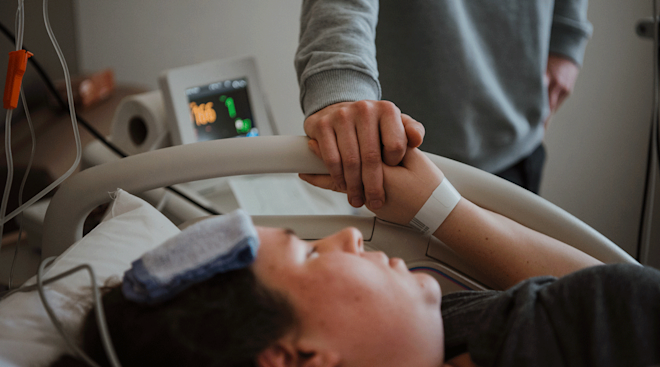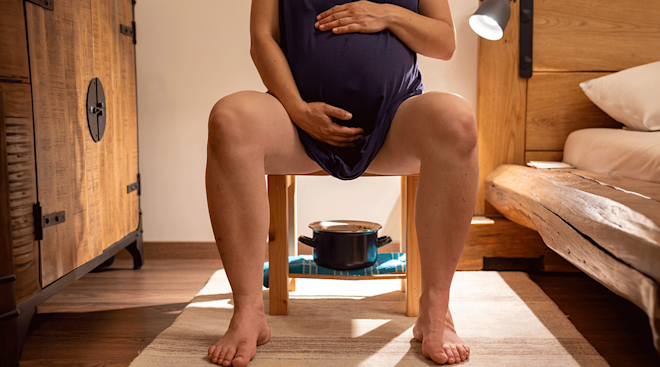When and How Is a Foley Bulb Used for Induction?
If you’ve been pregnant for what seems like ages, and baby still won’t come out, your doctor might recommend labor induction. Typically this is done between 39 and 41 weeks. There are several methods to induce labor, and your healthcare provider will talk to you about which ones may be right for you. One way to help kickstart labor is with the Foley bulb, aka Foley balloon, a catheter-like device that’s used to dilate and soften the cervix and induce the early stages of labor. So what is a Foley bulb induction, exactly? Read on for benefits, risks and more.
A Foley bulb is a flexible tube about the size of a straw, explains Sara Holt, CNM, MS, CAS, PMH-C, a certified nurse midwife in Portland, Oregon, and founder of Byenveni Baby, a community that offers lactation services, gynecology and full-scope midwifery, noting that it’s the same device that’s used as a urinary catheter. Your provider inserts it through your cervix and into your uterus.
Once the Foley bulb is in place, a small balloon at the end of it is inflated with sterile water, which puts pressure on the cervix and encourages it to open, says Holt. “This causes some mechanical dilation in addition to causing the release of hormones to help soften the cervix,” says Julie Lamppa, APRN, CNM, the director of midwifery services at Mayo Clinic in Rochester, Minnesota.
What is a Cook catheter?
A Cook catheter is a device similar to the Foley bulb, with a key difference: It has two balloons, rather than one, says Lamppa. “They’re filled on both sides of the cervix,” she explains. “One is near baby’s head, and one is in the vagina. It puts pressure on both sides of the cervix.” A Cook catheter provides greater dilation, says Holt: “After it’s expelled (generally without intervention), the birthing person may be up to 5 or 6 centimeters dilated,” she says.
Here’s how Foley bulb induction works, step-by-step.
-
First, your labor and delivery team will perform a cervical exam to make sure your cervix actually needs ripening (aka softening and opening), says Lamppa.
-
Next, your provider inserts the Foley bulb. “Sometimes a speculum and an additional instrument to hold the cervix are needed to help with placement,” says Lamppa. “It all depends how the cervix is angled within your body.”
-
Your provider will then fill the Foley balloon with about 1 ounce of saline solution, says Cleveland Clinic.
-
To create extra pressure, your provider might tape the Foley bulb to your thigh. Holt says this can speed things up. “This creates tension, which promotes the catheter being firmly against the cervix, and possibly working its way through the cervix faster,” she says.
-
If all goes well, the Foley bulb will help your cervix dilate to about 3 centimeters in up to 12 hours, and then fall out on its own, says Cleveland Clinic. Holt says the Foley balloon can remain in place for up to 24 hours.
After the Foley bulb successfully ripens your cervix, your provider might use additional methods to help induce contractions and keep moving labor along. These could include artificial rupture of membranes or medications such as Pitocin and Misoprostol.
Cleveland Clinic says that a Foley bulb will dilate the cervix within 12 hours for most people. But an entire labor induction can take hours to days from start to delivery. “It’s dependent on what your cervix is at the start of the induction and how your body reacts,” says Lamppa. “If your cervix is thick, firm and just barely open, cervical ripening will take longer than if it’s 50 percent thinned, soft and 1 to 2 centimeters.”
It all depends on who you ask. “It may feel awkward at first as you adjust to a rubber tube coming out of your vagina,” notes Lamppa. “You’ll likely feel pressure and cramping.” Holt says that it typically feels most uncomfortable as the balloon is being inserted, and about 15 to 20 minutes after it’s placed. “Many times this discomfort is relieved with hot packs, sitting in a bathtub or just changing positions,” she says. You might also notice some cramping as you expel the balloon, but the discomfort usually goes away once it’s out.
A big reason why someone might choose a Foley bulb induction is that there’s no medication involved, says Lamppa. Because of this, there’s no need for extended fetal monitoring, it can be done in an outpatient setting and it won’t make you contract too much, which could affect baby, she says.
There are some positive advantages to using a Foley bulb for induction. The experts at Cleveland Clinic list a few:
- Entirely drug-free
- Safe option for people who’ve had a C-section
- You’ll typically see dilation progress within 12 hours
- Low number of possible complications compared with other induction methods
- Can be used in addition to medication to speed up labor even more
Weighing the risks of using a Foley bulb for your induction? Thankfully, the list is pretty short. Holt says these are the potential risks of using a Foley balloon:
- Rarely, your amniotic sac can be ruptured during the procedure.
- Baby might not tolerate the balloon and there might be changes in the fetal heart rate—which is also rare, she points out. In this case, your provider will remove the balloon.
- It can be uncomfortable for the birthing person.
Foley bulb inductions are about 70 percent successful, according to Cleveland Clinic. But remember, a Foley bulb is meant to get your body ready for labor, not put you into labor right away, says Lamppa.
Doctors have many options up their sleeves when it comes to induction methods, which is great because there isn’t a one-size-fits-all solution to getting labor going. What works for one birthing person might not work for another. Other induction methods include, according to Nemours KidsHealth:
- Prostaglandin. Like the Foley bulb, a hormone called prostaglandin can be used to ripen the cervix and bring you closer to delivery. It can be inserted into the vagina or taken by mouth.
- Membrane sweeping. During a membrane sweep, your provider will insert a finger into the cervix and gently separate the amniotic sac from the uterine wall. This triggers the release of prostaglandin, which helps the cervix prepare for the main event.
- Amniotomy. Amniotomy, or artificial rupture of membranes, involves using a small hook to break your water and help bring on labor.
- Pitocin. To stimulate contractions, a doctor may give you Pitocin, a synthetic form of the hormone oxytocin, through an IV.
Of course, there are also various natural induction methods, which include walking, having sex and eating dates. While there’s scant scientific evidence to support these, some people do swear by them—and, for the most part, there’s no harm in trying. Be sure to consult with your healthcare provider before trying any new induction method.
Frequently Asked Questions
Can you go home after a Foley bulb induction?
If you’re experiencing a low-risk pregnancy, then absolutely. A Foley bulb induction can start as an outpatient procedure as long as your clinic has the protocol and process for this, Lamppa explains. “If there are any medical conditions that complicate the pregnancy, induction should be done inpatient,” she adds.
Do you have to remain in bed with a Foley bulb induction?
Not at all. In most cases, you’re free to walk around and move normally after the Foley bulb placement, says Lamppa.
Can you go to the bathroom with a Foley bulb induction?
Rest assured that you can use the bathroom with a Foley bulb induction. “It doesn’t impair the ability to urinate or have a bowel movement,” says Holt.
How long can a Foley bulb remain in?
Holt says that a Foley bulb can stay inside your cervix for up to 24 hours after placement.
Why and when would they remove a Foley bulb?
In most cases, a Foley bulb will fall out on its own once you’re sufficiently dilated, says Cleveland Clinic. Most doctors will remove a Foley balloon if it’s been inside your cervix for more than 24 hours, says Holt. But they’ll also remove the device if they notice any concerning clinical changes, such as unexpected bleeding, says Lamppa.
How long after Foley bulb induction does labor typically start?
Again, keep in mind that Foley bulbs rarely send people directly into labor, says Lamppa. This cervical ripening method is meant to prepare your body for labor. But in a nutshell, labor can start anywhere from a few hours to days following a Foley bulb induction. “It’s so hard to say!” says Holt. “During an induction, one of the tools that we use may be just the key that your body needs to begin laboring on its own. So, some people could start into labor from having a balloon placed, sometimes it can be from using a balloon and/or Misoprostol, and sometimes labor doesn’t start until Pitocin is initiated.”
A Foley bulb induction can be an effective, medication-free way to get your body ready for labor by helping open and soften your cervix. Along with other induction methods, it can help bring you that much closer to meeting baby. (Exciting!) Your healthcare provider can explain which induction method—or combination thereof—is best for you.
Please note: The Bump and the materials and information it contains are not intended to, and do not constitute, medical or other health advice or diagnosis and should not be used as such. You should always consult with a qualified physician or health professional about your specific circumstances.
Plus, more from The Bump:
Sara Holt, CNM, MS, CAS, PMH-C, is a certified nurse midwife who practices in Portland, Oregon. She’s the founder of Byenveni Baby, a community center and collective that offers full-scope midwifery, gynecology, lactation services, education and new-parent support. In her 25 years of experience, she has delivered more than 3,500 babies and has helped thousands more families navigate their pregnancies.
Julie Lamppa, APRN, CNM, is the director of midwifery services at Mayo Clinic in Rochester, Minnesota. She has 15 years of experience as a certified nurse midwife. She’s also the contributor to the Mayo Clinic Guide to a Healthy Pregnancy and co-author of Obstetricks: Mayo Clinic Tips and Tricks to Pregnancy, Birth and More.
American College of Obstetricians and Gynecologists, Induction of Labor at 39 Weeks, August 2022
American College of Obstetricians and Gynecologists, When Pregnancy Goes Past Your Due Date, November 2023
Cleveland Clinic, Foley Bulb Induction, August 2022
Nemours KidsHealth, Inducing Labor, January 2024
Learn how we ensure the accuracy of our content through our editorial and medical review process.
Navigate forward to interact with the calendar and select a date. Press the question mark key to get the keyboard shortcuts for changing dates.





















































